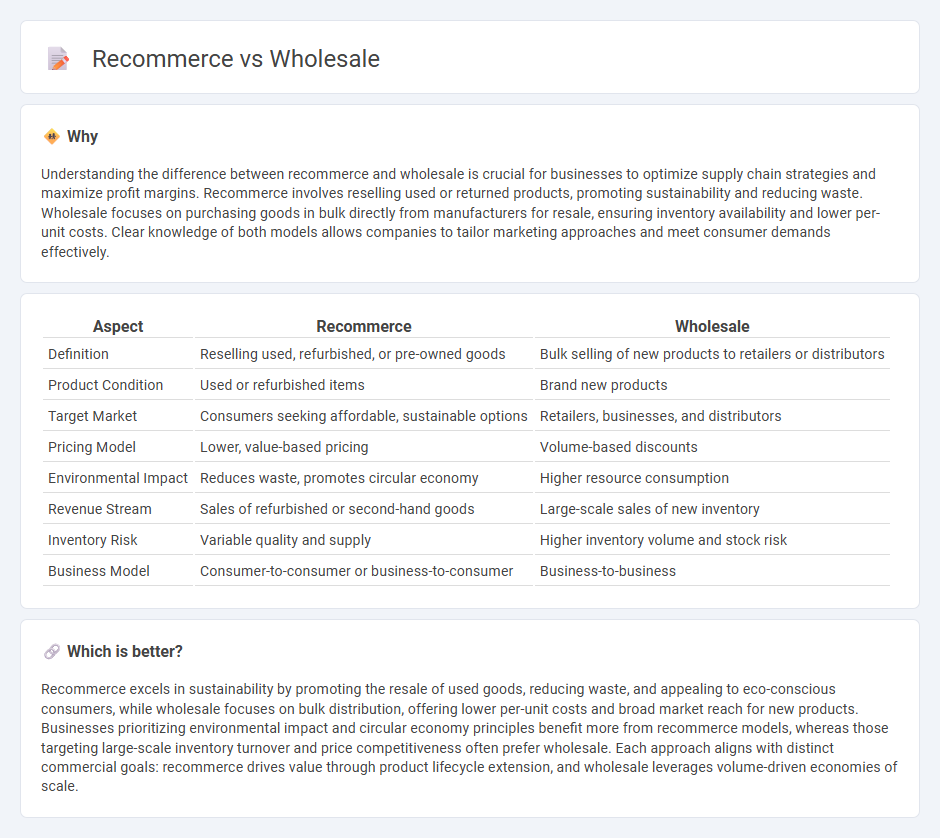
Recommerce focuses on the resale of used goods through online platforms, appealing to sustainability-conscious consumers and offering cost-effective alternatives to new products. Wholesale involves purchasing large quantities of new merchandise directly from manufacturers to be sold in bulk to retailers or other businesses, emphasizing volume discounts and supply chain efficiency. Explore the distinct advantages and operational models of recommerce and wholesale to understand their impact on modern commerce.
Why it is important
Understanding the difference between recommerce and wholesale is crucial for businesses to optimize supply chain strategies and maximize profit margins. Recommerce involves reselling used or returned products, promoting sustainability and reducing waste. Wholesale focuses on purchasing goods in bulk directly from manufacturers for resale, ensuring inventory availability and lower per-unit costs. Clear knowledge of both models allows companies to tailor marketing approaches and meet consumer demands effectively.
Comparison Table
| Aspect | Recommerce | Wholesale |
|---|---|---|
| Definition | Reselling used, refurbished, or pre-owned goods | Bulk selling of new products to retailers or distributors |
| Product Condition | Used or refurbished items | Brand new products |
| Target Market | Consumers seeking affordable, sustainable options | Retailers, businesses, and distributors |
| Pricing Model | Lower, value-based pricing | Volume-based discounts |
| Environmental Impact | Reduces waste, promotes circular economy | Higher resource consumption |
| Revenue Stream | Sales of refurbished or second-hand goods | Large-scale sales of new inventory |
| Inventory Risk | Variable quality and supply | Higher inventory volume and stock risk |
| Business Model | Consumer-to-consumer or business-to-consumer | Business-to-business |
Which is better?
Recommerce excels in sustainability by promoting the resale of used goods, reducing waste, and appealing to eco-conscious consumers, while wholesale focuses on bulk distribution, offering lower per-unit costs and broad market reach for new products. Businesses prioritizing environmental impact and circular economy principles benefit more from recommerce models, whereas those targeting large-scale inventory turnover and price competitiveness often prefer wholesale. Each approach aligns with distinct commercial goals: recommerce drives value through product lifecycle extension, and wholesale leverages volume-driven economies of scale.
Connection
Recommerce and wholesale intersect through the wholesale distribution of refurbished or returned goods, enabling businesses to acquire inventory at lower costs and reduce waste. Wholesale channels facilitate bulk transactions of second-hand products, promoting sustainable commerce practices and extending product lifecycles. This connection helps drive the circular economy by integrating resale markets with traditional wholesale supply chains.
Key Terms
Bulk purchasing
Wholesale involves purchasing large quantities of new products directly from manufacturers or distributors, offering significant cost savings per unit and opportunities for resale in retail markets. Recommerce focuses on bulk buying of pre-owned or refurbished goods, emphasizing sustainability and reduced environmental impact while catering to budget-conscious consumers. Explore the key benefits and strategies of bulk purchasing in both wholesale and recommerce to optimize your supply chain and profitability.
Secondary market
Wholesale in the secondary market involves bulk selling of pre-owned products to retailers or resellers, facilitating rapid inventory turnover and cost efficiencies. Recommerce emphasizes the refurbishment and direct resale of used goods, promoting sustainability and extending product lifecycle value. Discover how these models transform consumer behavior and retail strategies in the evolving secondary market.
Inventory turnover
Wholesale model emphasizes rapid inventory turnover by selling bulk quantities directly to retailers, reducing holding costs and minimizing risk of obsolescence. Recommerce focuses on refurbishing and reselling pre-owned goods, which often results in slower inventory turnover due to inspection and restoration processes. Explore deeper insights into optimizing inventory turnover strategies in both wholesale and recommerce markets.
Source and External Links
Wholesaling - Wikipedia - Wholesaling is the sale of goods in bulk to retailers, commercial users, or other wholesalers rather than to the end consumer, often involving purchasing directly from manufacturers at discounted rates.
How To Find Wholesale Suppliers (2025) - Shopify - Wholesale suppliers can be sourced through platforms like Shopify Collective, Alibaba, and AliExpress, which offer access to bulk products especially from manufacturers in China with options for dropshipping and private labeling.
Wholesale Central | Leading Source for Wholesale Products - Wholesale Central provides a comprehensive directory of wholesalers across many popular product categories such as apparel, electronics, health and beauty, and home decor to support retailers and businesses in bulk buying.
 dowidth.com
dowidth.com